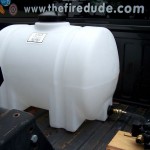
June is National Preparedness Month for Pets and a great time to make sure proper plans are in place to assure the safety of our special family members.
One of the lessons that rescuers learned with the tragedy of hurricane Katrina was that many people would rather take their chances facing a disaster than leave their pets. Unfortunately, this decision cost many lives.
Because of various laws, Red Cross shelters are not allowed to take in animals during an evacuation, so advanced planning is a must.
In the case of an emergency, you may not have a great deal of advanced warning. For pet emergency preparedness, here are some things you can do:
- Have an emergency kit for you and your pet stored in a location that is easy to access, such as by an exit door or garage. Your pet disaster preparedness kit should include the following items:
- Food and water for at least three days in airtight, waterproof containers.
- Medical records and emergency contact numbers in a clean plastic bag or waterproof container.
- Your pet’s medications.
- Pet first-aid kit that includes cotton bandage rolls, bandage tape and scissors, antibiotic ointment, flea and tick prevention, latex gloves, isopropyl alcohol and saline solution. You should be familiar with all of the items in the kit and know how to use them. (A pet first-aid book might also be beneficial).
- A pet carrier or crate is essential in an emergency.
- Be sure to have nearby a litter box, litter, newspaper, paper towels, plastic bags and household bleach.
- In case you become separated from your pet, a photo of your pet will help other identify the pet they are looking for.
- Favorite toys, treats, familiar bedding and other items will help your pet handle the disruption of the normal routine.
- Pet ID tags that list pertinent information, such as your name and telephone number, are crucial so rescuers can more quickly reunite you with your pet if you become separated. Your cell phone number and/or the number of where you’re planning to go is a good idea to be able to track you down quicker should you and your pet become separated. Also, list contact information on your pet’s carrier.
More and more people microchip or tattoo their pets as a means of more permanent identification. Some microchips are about the size of a grain of rice and are implanted in a pet’s shoulder area. Special scanners are used at animal shelters and pet hospitals to read the identity of your pet.
When disaster looms, bring pets inside so they won’t become fearful and run away.
And don’t forget to make arrangements to board your pet in a kennel, friend or relative’s house, or pet-friendly accommodation outside of the affected area as far in advance as possible.
Bottom line: Be prepared and your chances are much greater for you and your pet to survive in the event of a disaster or emergency situation.
Happy (and Safe) Pet Travels!
Tom James
PetTravelCenter.com


Pingback: watch Film-Noir online
DaveRsi
Hello Rick, I’ve read and appreciate your comments. Did not know of this gps, I’m
sure you have many skills and knowledge, that could benefit the adventerous
campers. Keep posting.
David
Rick Vogel
How do’s a person go about submitting an article about wilderness survival I have lived off the land from FT. Lewis Wash. to Panamn & Plenty of place’s Between & a Few Place’s Over-sea’s I would like to Forget about! But any-way How do’s a person submit an article for all the R.V.’s to Read! any-Help out there? or am I on My Own? Have yet to have a greeting sent or as Much as a Welcome To this Place you all are a friendly Bunch I will Give you That! Rick Vogel Retired Army! One of my Tip’s could save you life someday? & Maybe Not!
Rick Vogel
For $120:00 you can purchase a GPS that you friend’s can track your progress of your trip on Google & you can even send an S.O.S. Rescue signal DUH! I thought everyone had one! Rickey Vogel U.S.Army Retired Camping with Pet’s & Being STRANDED! BUNCH of NO G>P>S> carring People come’s with rescue Beacon get the rescuer’s within 3 meter’s of YOU!